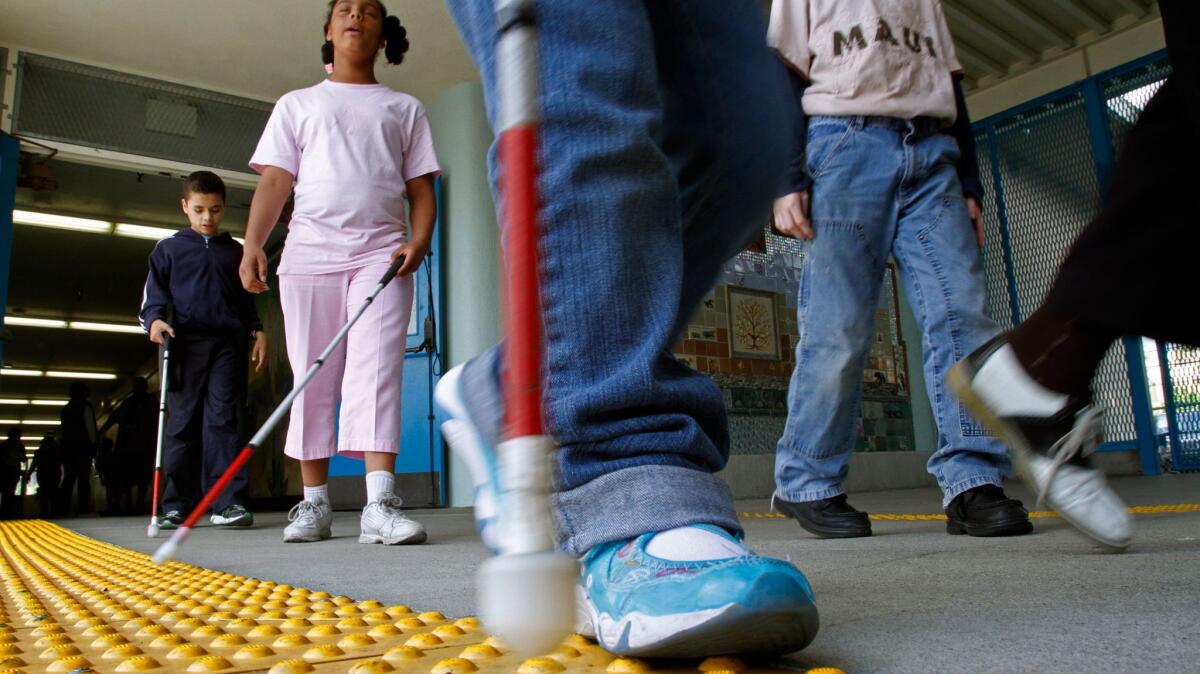13% of L.A. students have a significant disability. Is this a better deal for them?

The Los Angeles Unified School District, which educates about 64,500 students with disabilities, will regain full control over programs that serve their special needs, after decades of costly court-ordered outside supervision, officials announced this week.
The court-approved agreement will end a consent decree dating back to 1996, when district officials acknowledged they were not meeting their legal obligations to serve students with a broad range of disabilities, including dyslexia, autism, aphasia, blindness and paralysis.
The education of disabled students is a major part of the mission for the nation’s second-largest school system, where about 13% of students are classified as having a significant disability. To educate them this year, the district will spend about $1.75 billion out of a general fund budget of about $8 billion.
“This is an important milestone for Los Angeles Unified and the students and families we serve,” Supt. Austin Beutner said in a statement. “The Court has recognized the exceptional work we’ve done to serve the needs of students in our special education programs. We plan to build on the progress and make sure every student in Los Angeles Unified, including those with special needs, gets a great education.”
In a follow-up interview, Beutner said the agreement to end the supervision, approved last week, was endorsed by advocates for the disabled who were involved in the litigation.
The independent monitor appointed to oversee the district’s progress did not take part in the negotiations to end the consent decree and sharply criticized district efforts as recently as March.
The monitor, David Rostetter, took issue with the district’s claim that efforts to make campuses accessible to the disabled are “aggressive and unmatched in the country.”
“The ‘aggressive’ plan will address only one-third of its schools over the next 8-10 years,” Rostetter wrote.
“The laudatory tone of this response is misguided given that the District has yet to comply with the [Americans with Disabilities Act], when it was to have met these obligations by 1995.”
But attorney Robert Myers, who represents families of children with disabilities, described a long list of district improvements. For example, he said, in 2003-04, only 41% of children who were characterized as emotionally disturbed had a behavior support plan. In 2017-18, 100% of such children had such a plan.
The order to terminate the consent decree was signed by U.S. District Judge Ronald S.W. Lew and takes effect at the end of December.
The litigation that led to the decree dates back to 1993, when attorneys filed a class-action lawsuit that arose out of the experience of Chanda Smith.
Chanda, 17, had a visual disorder that made it difficult to process information. When she entered Manual Arts High School, no one asked whether she had ever received special education services — she had received special tutoring in middle school.
Her mother’s repeated requests that her child be placed in a special education program were ignored by school officials until the end of her second year at Manual Arts, when she was placed in a 30-day program.
Frustrated with her daughter’s treatment and unable to penetrate the district bureaucracy, Eliza Thompson “got out the Yellow Pages and started calling attorneys until I found someone who would help me,” she recalled later.
An evaluation showed that Chanda’s reading and math skills were at second- and third-grade levels and that she could not process numbers well enough to tell time.
In settling the suit, L.A. Unified agreed to goals that would have brought the district in line with its federal obligation to provide a “free and appropriate” education to every student. These included providing “timely information” to parents about their options and rights and following all legal timelines for services. The district also committed to removing obstacles that prevented disabled students from attending a regular campus and pledged to provide programs that would serve students in the “least restrictive” environment.
In 2003, all parties agreed to a revised pact that included specific measurable goals in 18 areas, with the idea that the district would achieve them by 2006.
That did not happen and, arguably, as Rostetter wrote, it hasn’t happened yet.
Beutner said the situation had changed because advocates accepted that the district has made remarkable progress and that the specific goals of the consent decree exceed what is being asked of other school systems. In that light, he said, it is better to spend more on services to students than the machinery of the independent monitor, which he estimated at a cost of $3 million to $5 million per year.
In an interview Tuesday, Rostetter said the district is overstating the cost of the independent monitor’s office in recent years, which he put at “less than $800,000 on average.” All the same, he said, “it is probably time for this consent decree to be terminated,” even though there are significant areas in which the district needs to improve its services.
Spending for special education has long been a thorny issue. The federal government has pledged to pay for 40% of the cost of these programs, but has provided only about 16%, according to district figures. And the state allocates money for special education based on total enrollment rather than on the number of disabled students or the severity of their impairments.
In the past, advocates have worried that L.A. Unified would shortchange students with disabilities without a powerful, independent monitor — although that same concern would theoretically apply to other school systems as well.
More to Read
Sign up for Essential California
The most important California stories and recommendations in your inbox every morning.
You may occasionally receive promotional content from the Los Angeles Times.











